Red-headed weaver facts for kids
Quick facts for kids Red-headed weaver |
|
|---|---|
 |
|
| Male | |
| Conservation status | |
| Scientific classification | |
| Genus: |
Anaplectes
|
| Species: |
rubriceps
|
The red-headed weaver (scientific name: Anaplectes rubriceps) is a colorful bird found in many parts of Africa. It belongs to the Ploceidae family, which includes many types of weavers. This bird is the only species in its special genus called Anaplectes.
You can find red-headed weavers mainly in eastern and southern Africa. They live in countries like Zambia, Zimbabwe, Mozambique, and Botswana. These birds love to live in savanna areas, bushland, and other places with lots of trees. Their population is currently stable, meaning there are plenty of them around.
Contents
What They Look Like
Red-headed weavers have a white belly and brown wings. The male birds in the northern parts of Africa have a bright red head. This red head helps them stand out to the female birds.
Female red-headed weavers in the north have a more brownish head. But in southern Africa, the females have yellow heads and yellow spots on their wings! All red-headed weavers have a beak that is fairly long and pointed. They also have short, strong claws.
A typical group of red-headed weavers usually has one male bird with about eight or nine female birds.
Their Nests
Red-headed weavers build their nests using dry sticks they collect. Their nests often hang from trees and are shaped like a raindrop. Sometimes, they even build nests on human-made structures. A cool thing about their nests is the long tunnel entrance. This is a special feature often seen in nests made by birds from the Malimbus group.
How They Behave
Red-headed weavers are busy birds! They often search for insects on leaves and branches. They might do this alone or with another bird. You can spot them looking for food on bushes, small trees, and even large trees.
These birds are clever hunters. They sometimes hang upside-down to use their beak to open up bunches of dead leaves. They also poke into tree bark to find hidden insects. Red-headed weavers can even catch flying insects like termites and moths in the air. If they catch a large insect, they might hit it against a surface to break off its wings. They also peck at spider nests to get their prey.
What They Eat
While they mostly eat insects, red-headed weavers also eat some plant materials. They enjoy acacia seeds, Premna fruit, and berries from mistletoe plants. They have also been seen drinking nectar from flowers of different plants. Very rarely, they have even been seen eating drying meat left outside!
Scientists have looked at what's inside their stomachs. They found bugs, beetles, mantids, and termites. When feeding their babies, they give them spiders, tiny snails, and fruit pulp.
Where They Live
The red-headed weaver lives in many different places across Africa. You can find them from Senegambia in the west all the way to Ethiopia and northwest Somalia in the east. They also live southwards in countries like Mozambique, northern Namibia, northern and eastern Botswana, Zimbabwe, northeast South Africa, eastern Eswatini, and northeast KwaZulu-Natal.
Lifespan
The oldest red-headed weaver that scientists have recorded lived for 9 years and 1 month. However, studies suggest that these birds might be able to live for up to 11 years in total.
Images for kids





